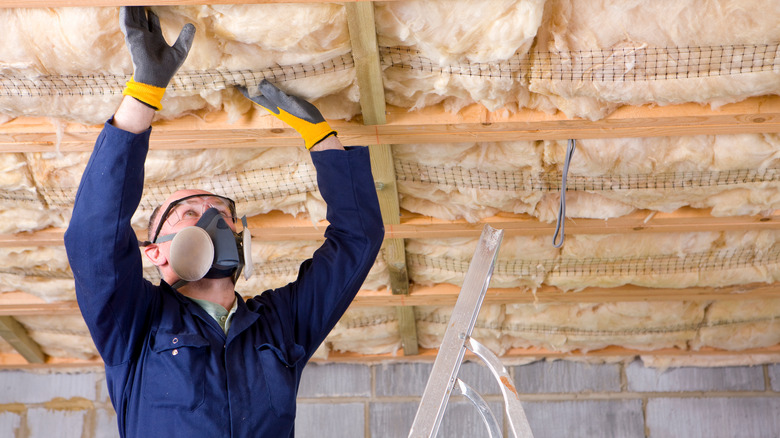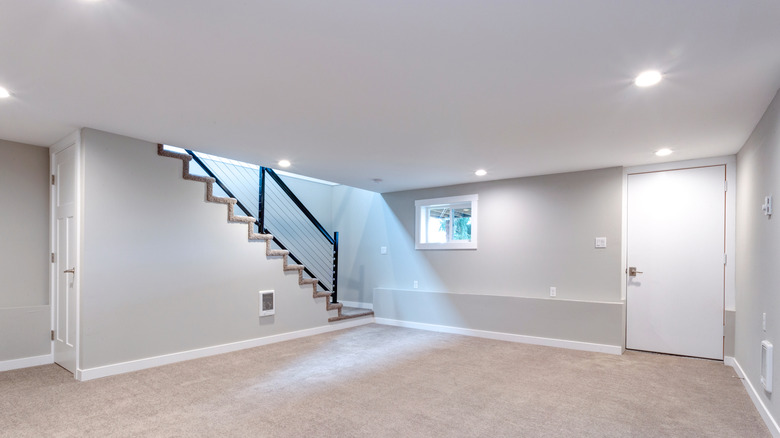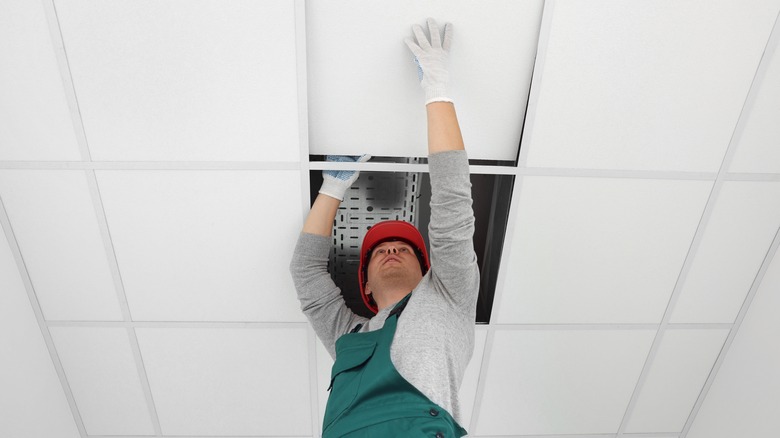Is It Cheaper To Add Drywall Or A Drop Ceiling To Your Basement? What We Know
It's time to tackle the basement ceiling. You may not spend much time thinking about it, but it plays an aesthetic role in your home, and when exposed, it may even contribute to the colder temperature in the basement. If you're planning to replace or install a new ceiling in the basement, it's important to consider several options available to you. Is it cheaper to drywall or add a drop ceiling to your basement? Here's what we know.
You could go all out and have a stunning ceiling design to add the perfect touch to your basement's look. However, drop ceilings and drywall are viable options if you want to save money. A drywall ceiling uses solid pieces of drywall material to cover the basement's ceiling beams. It looks much like any other ceiling in your home. A drop ceiling is much different. It involves a lightweight grid system that spaces the ceiling with individual tiles that drop into place. While it looks like a solid ceiling, each of the tiles can pop up, allowing for ongoing access to whatever is behind it. As you consider both options, you'll likely find that drywall tends to be less expensive to install than a drop ceiling due to the complexity of the grid system. However, prices vary considerably, and there are some huge (and costly) reasons why drywalling your basement ceiling is more problematic than it may be worth in any savings.
Breaking down the cost of drywall versus drop ceilings for basements
While a handy DIYer can certainly tackle these projects themselves, it's important to look at the complexity of these basement ceiling options to understand the cost better. Drywall requires fixing a sheet of drywall material to studs, securing it in place, and then mudding the seams to create a clean finish before painting your ceiling. You could use a popcorn-style or stucco-style finish so that you don't have to have perfect lines. A drop ceiling requires the installation of a metal grid across the ceiling, which will take some time to put into place. It uses more material, too. '
How does this impact the price? You can expect to pay between $1.50 and $3.00 per square foot to add a drywall ceiling to your basement. Some estimates are a bit higher: as much as $4.35 per square foot. This could be due to location, too. By contrast, installing a drop ceiling will range between $2.00 and $5.00 per square foot or even higher at about $5.50 per square foot, making it more expensive overall. The more complicated the grid system needs to be due to the size and shape of your ceiling, the more impacted the costs are. In both of these situations, doing the work yourself could help to lower the total price point, but material-wise, drywall tends to be less expensive than the purchase of ceiling tiles and the drop-in ceiling system.
Factors to consider before installing a ceiling in your basement
Drop ceilings have an essential functional aspect for most basement ceilings. That is, they provide access to the water lines and drains that run from the upper floors of your home to the basement and sewers. In the ideal situation, you never have to deal with a leak with one of these plumbing fixtures. But if you do, and you have a drop ceiling, you can pop open ceiling tiles to find the leak's origin, fix it, and replace the tile. However, it's not as easy to find where your basement leak comes from if you have a drywall ceiling without access.
Still, drywall ceilings offer numerous additional benefits, including better sound control (though higher-quality, acoustical drop ceilings are a competitive option for this reason), and they tend to have a better overall aesthetic. Drywall also has a higher resell value for your home in many places. It's more professional looking and can be enhanced in a variety of ways. Ultimately, both options are viable, though the best option may be to invest a bit more in a stylish, even luxury finished drop ceiling so that you maintain that access you likely need to your home's plumbing system. From a cost standpoint, remember that it's often easier and less expensive to replace a few drop ceiling tiles than to have to remove and start over with drywall if there's a leak.


